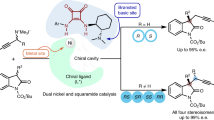Abstract
THE need for enantiomerically pure pharmaceuticals and insecticides drives the search for new catalysts that can perform asymmetric reactions with high enantiomeric selectivity. Many chiral transformations are accomplished using homogeneous catalysts1. Recently we reported2 a heterogeneous catalyst for asymmetric hydrogenation reactions, in which an organometallic catalytic complex is held in a film of water on a porous hydrophilic support, while the reactants and products remain within a hydrophobic organic phase. Such systems provide a large interfacial area between the catalytic phase and the solvent, and should facilitate the separation of product from catalyst. Our previous system2 gave selectivities of only about 70% enantiomeric excess, however, whereas values of at least 95% are needed for practical utility. Here we describe a modified process in which an enantiomeric excess of 96% is obtained for the asymmetric reduction of 2-(6′-methoxy-2′-naphthyl)acrylic acid to the commercially important anti-inflammatory agent naproxen. We use ethylene glycol as the hydrophilic liquid phase containing the chiral catalyst, which effectively prevents the leaching of the complex into the organic phase. Our results show that these supported-phase asymmetric catalytic systems have the potential to become commercially viable.
Similar content being viewed by others
References
Parshall, G. W. & Nugent, W. A. CHEMTECH March, 184–190 (1988); CHEMTECH May, 314–320 (1988); CHEMTECH June, 376–383 (1988).
Wan, K. T. & Davis, M. E. J. Catal. 148, 1–8 (1994).
Arhancet, J. P., Davis, M. E., Merola, J. S. & Hanson, B. E. Nature 339, 454–455 (1988).
Davis, M. E. Chemtech August, 498–502 (1992).
Arhancet, J. P., Davis, M. E. & Hanson, B. E. J. Catal. 121, 327–339 (1990); 129, 94–99; 100–105 (1991).
Noyori, R. & Takaya, H. J. org. Chem. 52, 3174–3176 (1987).
Chan, A. S. C., Laneman, S. A. & Miller, R. E. in Selectivity In Catalysis Ch. 3 (eds Davis, M. E. & Suib, S. L.) 27–39 (Symp. Ser. 517, American Chemical Soc., Washington DC, 1993).
Wan, K. T. & Davis, M. E. J. chem. Soc., chem. Commun. 1262–1264 (1993).
Wan, K. T. & Davis, M. E. Tetrahedron: Asymmetry 4, 2461–2468 (1993).
Hoke, J. B., Hollis, L. S. & Stern, E. W. J. organomet. Chem. 455, 193–196 (1993).
Guo, I., Hanson, B. E., Toth, I. & Davis, M. E. J. molec. Catal. 70, 363–368 (1991).
Fache, E., Mercier, C., Pagnier, N., Despeyroux, B. & Panster, P. J. molec. Catal. 79, 117–131 (1993).
Author information
Authors and Affiliations
Rights and permissions
About this article
Cite this article
Wan, K., Davis, M. Design and synthesis of a heterogeneous asymmetric catalyst. Nature 370, 449–450 (1994). https://doi.org/10.1038/370449a0
Received:
Accepted:
Issue Date:
DOI: https://doi.org/10.1038/370449a0
- Springer Nature Limited
This article is cited by
-
Catalytic synthesis of new pyrazolo [3,4-b] pyridine via a cooperative vinylogous anomeric-based oxidation
Scientific Reports (2022)
-
Catalytic performance of Ni–Cu/TiO2 catalyst for conversion of H2S and SO2 to sulfur
International Journal of Industrial Chemistry (2020)
-
Facile Synthesis of a New Chiral BINOL–Silica Hybrid Catalyst for Asymmetric Diels–Alder and Aza Michael Reactions
Catalysis Letters (2018)
-
Electron crystallography for determining the handedness of a chiral zeolite nanocrystal
Nature Materials (2017)
-
Effect of different synthetic routes on the performance of propylene hydroformylation over 3V-PPh3 polymer supported Rh catalysts
Reaction Kinetics, Mechanisms and Catalysis (2015)





